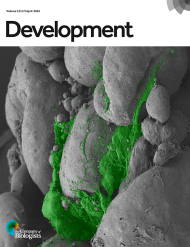Individual- and population-level drivers of consistent foraging success across environments
Posted on: 17 March 2018
Preprint posted on 6 February 2018
Article now published in Nature Ecology & Evolution at http://dx.doi.org/10.1038/s41559-018-0658-4
Is the performance of individual fishes maintained across environments? Snijders et al. find consistency in the foraging success of guppies in different natural pools.
Selected by Rasmus ErnCategories: animal behavior and cognition, evolutionary biology, physiology
Summary:
Foraging success is an important trait for Darwinian fitness (i.e., the ability to survive and reproduce) that may be constraint by changes in the environment. However, animals may possess behavioural traits that enable them to maintain foraging success under fluctuating environmental conditions. Identifying such traits is important for our understanding of the relationship between the responses of species at the organism level and their overall performance at population and ecosystem levels.
In fishes, assessing the behavioural responses of individuals in their natural environment can be extremely challenging, but guppies inhabiting shallow, isolated pools in a rainforest river provide an ideal system for such studies. Using video equipment and fluorescent color tagging to identify individuals, Snijders et al. assessed the ability of guppies, (Poecilia reticulata) to locate and reach novel food patches in two different natural pools. First, individuals were assessed in batches of 6-8 fish for their ability to forage in one pool and then they were translocated to a second pool where they were assessed again the following day. In addition to foraging success, the authors also assessed sex and proportion of time individuals spend near other individuals (i.e., social tendency).
Findings:
- Individuals that reached more food patches in the first pool also reached more food patches in the second pool.
- More social fish reached more food patches than less social fish.
- Males reached more food patches than females.
- Females appear to compensate for fewer food patches reached by having a higher bit rate than males.
Snijders et al. conclude that individual traits such as sex and social tendency can be important drivers of consistent foraging success across different environments in the wild.
Interest:
I am interested in this preprint because it documents consistency in a performance trait across different environments in the wild as researchers are performing an increasing number of studies on the physiological and behavioural responses of individuals to environmental stressors. Incorporating the results of such studies into ecological species distribution models would be expected to greatly improve the ability of modelers to accurately predict the biogeographic responses of fishes to climate change.
The findings of this study opens up the possibility of running parallel experiments, testing whether the responses of individuals to environmental stressors under controlled laboratory conditions correlates with the responses of individuals to the same stressors in the wild. Studies like these are vital if we are to bridge the gaps between data collected on the responses of fishes to environmental changes at the organism, population and ecosystem levels.
Future directions:
Are there specific constant environmental (elevated temperature, hypoxia, turbidity) or physiological (starvation) conditions under which the observed consistency in foraging success across different natural pools disappear? And are these reproducible in the lab?
Related literature:
JW Brownscombe, SJ Cooke, DA Algera, KC Hanson, EJ Eliason, NJ Burnett, AJ Danylchuk, SG Hinch, AP Farrell (2017). Ecology of exercise in wild fish: Integrating concepts of individual physiological capacity, behavior, and fitness through diverse case studies. Integrative and Comparative Biology 57, 281–292. DOI: 10.1093/icb/icx012
Read preprintSign up to customise the site to your preferences and to receive alerts
Register hereAlso in the animal behavior and cognition category:
Responses to conflicting binocular stimuli in mouse primary visual cortex
Maitri Manjunath
Effects of transcranial photobiomodulation on peripheral biomarkers associated with oxidative stress and complex IV activity in the prefrontal cortex in rats subjected to chronic mild stress
Rickson Ribeiro, Marcus Oliveira
Psychedelics Align Brain Activity with Context
Loïk Holdrinet et al.
Also in the evolutionary biology category:
A high-coverage genome from a 200,000-year-old Denisovan
AND
A global map for introgressed structural variation and selection in humans
Siddharth Singh
Dissecting Gene Regulatory Networks Governing Human Cortical Cell Fate
Manuel Lessi
Beyond venomous fangs: Uloboridae spiders have lost their venom but not their toxicity
Daniel Fernando Reyes Enríquez, Marcus Oliveira
Also in the physiology category:
Imaging cellular activity simultaneously across all organs of a vertebrate reveals body-wide circuits
Muhammed Sinan Malik
Wide-ranging behavioral dysfunction in two mouse models of pathological human variants in the GRIK2 kainate receptor gene
Pushpinder Singh
Fibroblast growth factor 21 regulates neuromuscular junction innervation through HDAC4 in denervation-induced skeletal muscle atrophy
Jórdan Sampar
preLists in the animal behavior and cognition category:
Biologists @ 100 conference preList
This preList aims to capture all preprints being discussed at the Biologists @100 conference in Liverpool, UK, either as part of the poster sessions or the (flash/short/full-length) talks.
| List by | Reinier Prosee, Jonathan Townson |
9th International Symposium on the Biology of Vertebrate Sex Determination
This preList contains preprints discussed during the 9th International Symposium on the Biology of Vertebrate Sex Determination. This conference was held in Kona, Hawaii from April 17th to 21st 2023.
| List by | Martin Estermann |
Bats
A list of preprints dealing with the ecology, evolution and behavior of bats
| List by | Baheerathan Murugavel |
FENS 2020
A collection of preprints presented during the virtual meeting of the Federation of European Neuroscience Societies (FENS) in 2020
| List by | Ana Dorrego-Rivas |
Also in the evolutionary biology category:
November in preprints – DevBio & Stem cell biology
preLighters with expertise across developmental and stem cell biology have nominated a few developmental and stem cell biology (and related) preprints posted in November they’re excited about and explain in a single paragraph why. Concise preprint highlights, prepared by the preLighter community – a quick way to spot upcoming trends, new methods and fresh ideas.
| List by | Aline Grata et al. |
October in preprints – DevBio & Stem cell biology
Each month, preLighters with expertise across developmental and stem cell biology nominate a few recent developmental and stem cell biology (and related) preprints they’re excited about and explain in a single paragraph why. Short, snappy picks from working scientists — a quick way to spot fresh ideas, bold methods and papers worth reading in full. These preprints can all be found in the October preprint list published on the Node.
| List by | Deevitha Balasubramanian et al. |
October in preprints – Cell biology edition
Different preLighters, with expertise across cell biology, have worked together to create this preprint reading list for researchers with an interest in cell biology. This month, most picks fall under (1) Cell organelles and organisation, followed by (2) Mechanosignaling and mechanotransduction, (3) Cell cycle and division and (4) Cell migration
| List by | Matthew Davies et al. |
Biologists @ 100 conference preList
This preList aims to capture all preprints being discussed at the Biologists @100 conference in Liverpool, UK, either as part of the poster sessions or the (flash/short/full-length) talks.
| List by | Reinier Prosee, Jonathan Townson |
‘In preprints’ from Development 2022-2023
A list of the preprints featured in Development's 'In preprints' articles between 2022-2023
| List by | Alex Eve, Katherine Brown |
preLights peer support – preprints of interest
This is a preprint repository to organise the preprints and preLights covered through the 'preLights peer support' initiative.
| List by | preLights peer support |
EMBO | EMBL Symposium: The organism and its environment
This preList contains preprints discussed during the 'EMBO | EMBL Symposium: The organism and its environment', organised at EMBL Heidelberg, Germany (May 2023).
| List by | Girish Kale |
9th International Symposium on the Biology of Vertebrate Sex Determination
This preList contains preprints discussed during the 9th International Symposium on the Biology of Vertebrate Sex Determination. This conference was held in Kona, Hawaii from April 17th to 21st 2023.
| List by | Martin Estermann |
EMBL Synthetic Morphogenesis: From Gene Circuits to Tissue Architecture (2021)
A list of preprints mentioned at the #EESmorphoG virtual meeting in 2021.
| List by | Alex Eve |
Planar Cell Polarity – PCP
This preList contains preprints about the latest findings on Planar Cell Polarity (PCP) in various model organisms at the molecular, cellular and tissue levels.
| List by | Ana Dorrego-Rivas |
TAGC 2020
Preprints recently presented at the virtual Allied Genetics Conference, April 22-26, 2020. #TAGC20
| List by | Maiko Kitaoka et al. |
ECFG15 – Fungal biology
Preprints presented at 15th European Conference on Fungal Genetics 17-20 February 2020 Rome
| List by | Hiral Shah |
COVID-19 / SARS-CoV-2 preprints
List of important preprints dealing with the ongoing coronavirus outbreak. See http://covidpreprints.com for additional resources and timeline, and https://connect.biorxiv.org/relate/content/181 for full list of bioRxiv and medRxiv preprints on this topic
| List by | Dey Lab, Zhang-He Goh |
1
SDB 78th Annual Meeting 2019
A curation of the preprints presented at the SDB meeting in Boston, July 26-30 2019. The preList will be updated throughout the duration of the meeting.
| List by | Alex Eve |
Pattern formation during development
The aim of this preList is to integrate results about the mechanisms that govern patterning during development, from genes implicated in the processes to theoritical models of pattern formation in nature.
| List by | Alexa Sadier |
Also in the physiology category:
October in preprints – DevBio & Stem cell biology
Each month, preLighters with expertise across developmental and stem cell biology nominate a few recent developmental and stem cell biology (and related) preprints they’re excited about and explain in a single paragraph why. Short, snappy picks from working scientists — a quick way to spot fresh ideas, bold methods and papers worth reading in full. These preprints can all be found in the October preprint list published on the Node.
| List by | Deevitha Balasubramanian et al. |
Biologists @ 100 conference preList
This preList aims to capture all preprints being discussed at the Biologists @100 conference in Liverpool, UK, either as part of the poster sessions or the (flash/short/full-length) talks.
| List by | Reinier Prosee, Jonathan Townson |
Fibroblasts
The advances in fibroblast biology preList explores the recent discoveries and preprints of the fibroblast world. Get ready to immerse yourself with this list created for fibroblasts aficionados and lovers, and beyond. Here, my goal is to include preprints of fibroblast biology, heterogeneity, fate, extracellular matrix, behavior, topography, single-cell atlases, spatial transcriptomics, and their matrix!
| List by | Osvaldo Contreras |
FENS 2020
A collection of preprints presented during the virtual meeting of the Federation of European Neuroscience Societies (FENS) in 2020
| List by | Ana Dorrego-Rivas |
TAGC 2020
Preprints recently presented at the virtual Allied Genetics Conference, April 22-26, 2020. #TAGC20
| List by | Maiko Kitaoka et al. |
Autophagy
Preprints on autophagy and lysosomal degradation and its role in neurodegeneration and disease. Includes molecular mechanisms, upstream signalling and regulation as well as studies on pharmaceutical interventions to upregulate the process.
| List by | Sandra Malmgren Hill |
Cellular metabolism
A curated list of preprints related to cellular metabolism at Biorxiv by Pablo Ranea Robles from the Prelights community. Special interest on lipid metabolism, peroxisomes and mitochondria.
| List by | Pablo Ranea Robles |











 (No Ratings Yet)
(No Ratings Yet)